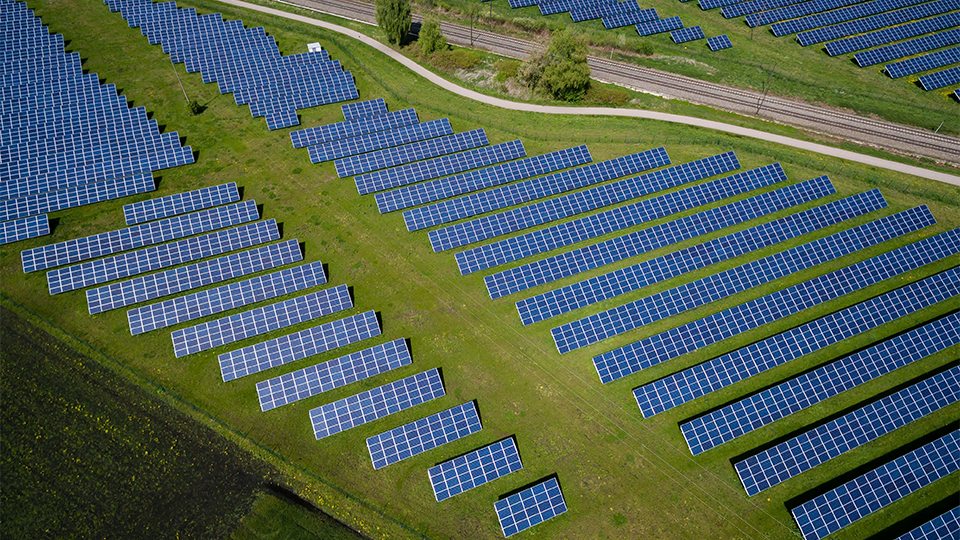
Solar arrays can improve water quality, but placement matters!
Lake and rivers throughout Minnesota are negatively impacted by runoff from agricultural lands. Unintended transport of nitrate, phosphorus, and sediment has compromised safe drinking water, accelerated harmful algal blooms in lakes, impaired aquatic function due to cloudiness from sediment, and eroded soil fertility. Experts estimate that improving these water quality issues through conventional conservation practices could cost more than a billion dollars per year. It's clear that new, more cost-effective approaches are necessary if we are going to meet our water quality goals.
Water quality is just one of several environmental issues that is tied to the agricultural landscape. Loss of grassland habitat and the associated declines in pollinators, Monarch butterflies, songbirds, and pheasants are of equal concern, as is the potential for agricultural land to reduce greenhouse gases. The common denominator linking water quality, habitat, and climate change in the rural landscape is the intensification of corn/soybeans and the loss of perennial crops and grasslands.
Placing perennial vegetation back on the rural landscape, specifically in areas critical for water quality, may be our single best approach to improve all of these environmental issues. The challenge? Finding a way to make this affordable while maintaining farm profitability. Thoughtful, targeted placement of solar arrays, coupled with conservation pastures, offers one of the best opportunities to address this challenge.
Ground-mounted, grid-scale solar is expanding rapidly. When combined with an understory of “prairie plantings,” these arrays also provide significant benefit to pollinators and other grassland wildlife, and sequester carbon dioxide in the soils. The plantings also could offer the dual use as conservation pasture for sheep, thus allowing solar installations to provide both kilowatts and calories.
But unless these arrays are placed in critical water areas, they will result in minimal benefits to water quality. In other words, we could gain the additional benefits to water quality if we were more targeted in our placement of new solar installations. Rather than expansive solar arrays that remove entire farms from production, we could strategically distribute these arrays across our agricultural landscapes at nominal additional cost, and thus expand environmental benefits and reduce the impact to whole farms.
The Science Museum of Minnesota, led by Director of Global Change Initiatives Patrick Hamilton and St. Croix Watershed Research Station senior scientist Shawn Schottler, has developed a strategy to target areas for solar development by identifying lands that are both cumbersome to farm and are in critical water areas. Leasing these smaller, edge-of-field areas would allow the farmers to maintain most of their existing cropland, while augmenting their income with a secure long-term revenue stream and increasing environmental benefits.
The Science Museum has conducted a preliminary exercise in a small agricultural watershed. We identified fields adjacent to waterways that could be “squared off." Engineers at two private solar companies evaluated examples of these “solar riparian pastures" and estimated that the strategy would likely only increase the construction costs of these projects by 0.5 to 1.0 percent. Our modeling efforts show that, if solar installations were concentrated in critical water areas, we could see a combined reduction of nitrate, phosphorus, and sediment of nearly 60 percent!
Solar energy is going to expand on the rural landscape. If we are proactive about how we place solar arrays, we could have one of the most cost-effective methods to improve water quality while maintaining farm profitability.
Figure at upper right: Modeled example of a solar conservation pasture placed in a critical water area near the south fork of the Watanwan River. This field is about eight acres in size and demonstrates how "squaring off" fields near waterways can provide water quality benefits with minimal impact on existing farming practices. A solar array on this site could provide more than 1 MW of energy at an increased installation cost of less than 1%. Clustering solar-riparian pastures in this watershed could result in a 60% combined decrease in nutrients and sediment that negatively impact water quality.